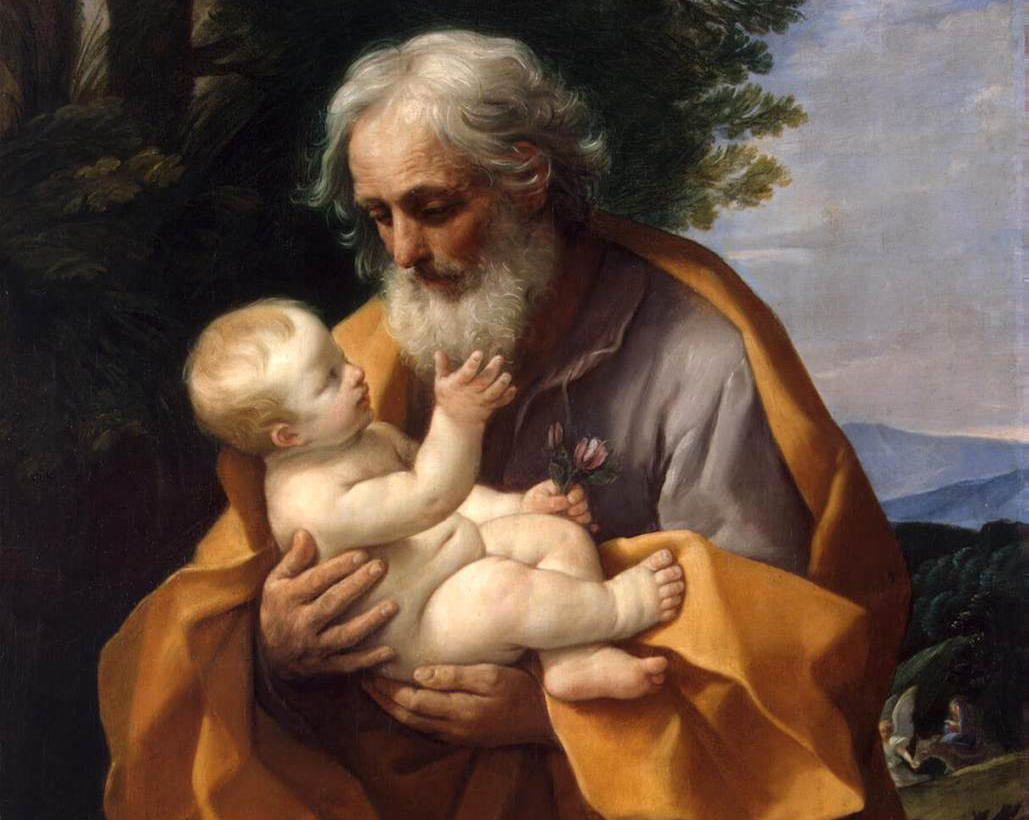St. Joseph was the husband of Mary, the mother of Jesus. According to the earliest Christian traditions, he was a carpenter or woodworker. The Gospel of Matthew calls him a “righteous man,” meaning he was an observant Jew who obeyed God’s law.
Joseph was engaged to Mary, but when he discovered that she was pregnant with Jesus, he decided to call off the marriage—but “quietly,” since the penalty for adultery was death by stoning. However, the angel of the Lord told him in a dream that he should go ahead with the marriage because Mary’s child was conceived by the Holy Spirit.
This was the first of four divinely inspired dreams that are recorded in the Gospel of Matthew; for this reason, he is sometimes called “the dreamer.” After each of these dreams, “he did as the angel of the Lord had commanded him” (Matthew 1:24).
For more ways to celebrate the saints, sign up for our weekly enewsletter here.
The Gospel of Luke tells us that when Jesus was twelve, Joseph took him and Mary to Jerusalem to visit the Temple. They became separated, and Mary and Joseph spent three days looking for him. When they found him, Mary said to Jesus: “Son, why have you done this to us? Your father and I have been looking for you with great anxiety.” In reply, Jesus said: “Why were you looking for me? Did you not know that I must be in my Father’s house?” (Luke 2:48-49)
Mary referred to Joseph as Jesus’ father, honoring his role in caring for and protecting Jesus, and raising him in the Jewish faith; the reply of Jesus refers to God as his Father, and introduces a common theme in his preaching: Our faithfulness to God must come before even our closest human relationships.
The Solemnity of St. Joseph is celebrated on March 19 (or the next available date, if it falls on a Sunday). He is also honored as the patron saint of workers on May 1.
A Story about St. Joseph
by Maria LaVoy
From Living Sparks of God: Stories of Saints for Kids to Color
Jesus looked up at him. No words needed to be spoken. In the silence, they understood one another. As Jesus waited for Joseph’s approval, Joseph chuckled to himself. He didn’t doubt that one day the student would surpass the teacher! It was clear the skills of Joseph’s trade came naturally to Jesus.
“Your mother will love it!” Joseph said with great affection. As the earthy smell of wood shavings filled the air, Joseph thought about how much he treasured the simple time they got to spend working alongside one another, perhaps even more now. Was it already a month ago when he and Mary had been filled with such great anxiety as they searched for Jesus in Jerusalem? Joseph’s heart tightened as he thought about the fear he and Mary had felt when they couldn’t find him.
A sudden stab of pain shot through Joseph’s finger.
“I’m so sorry, Father!” Jesus exclaimed.
“Don’t worry, Jesus . . . my finger and the hammer are not strangers. They have met many times before!” Joseph laughed and tousled Jesus’ hair. “But what do you say we take a break for lunch?”
A Child’s Prayer to St. Joseph
St. Joseph,
watch over me
and care for me
just as you cared for
the child Jesus;
and by your help,
may I come to know
your Son,
and so grow
in strength
and wisdom
and the favor of God.
Amen.
More about St. Joseph
| Born | Bethlehem c. 90 BC (apocryphal date) |
|---|---|
| Died | Nazareth, July 20, AD 18 (aged 90, apocryphal date) |
| Feast |
March 19 – Saint Joseph, Husband of Mary (Western Christianity), May 1 – St Joseph the Worker (Roman Catholic Church), The Sunday after the Nativity of the Lord (Eastern Christianity) |
| Attributes | Carpenter’s square or tools, the infant Jesus, staff with lily blossoms, two turtle doves, rod of spikenard. |
| Patronage | Catholic Church, unborn children, fathers, immigrants, workers, employment, traveler, carpenters, realtors, against doubt and hesitation, and of a happy death, Canada, Croatia, Korea, Zapotlan, Vietnam, Mandaue City, Cebu, Philippines, and many others. |
Read even more about St. Joseph at Simply Catholic.
St. Joseph’s Day Traditions
Want to celebrate St. Joseph’s Day in a special way? Here are some ways Catholics have traditionally celebrated the day around the world. (This information is adapted from the Wikipedia St. Joseph’s Day article.)
United States
In New Orleans, which was a major port of entry for Sicilian immigrants during the late 19th century, the Feast of St. Joseph is a city-wide event. Both public and private St. Joseph’s altars are traditionally built. The altars are usually open to any visitor who wishes to pay homage. The food is generally distributed to charity after the altar is dismantled.
There are also parades in honor of St. Joseph and the Italian population of New Orleans which are similar to the many marching clubs and truck parades of Mardi Gras and St. Patrick’s Day. In addition to the above traditions, some groups of Mardi Gras Indians stage their last procession of the season on the Sunday nearest to St. Joseph’s Day otherwise known as “Super Sunday,” after which their costumes are dismantled.
Saint Joseph’s Day is also celebrated in other American communities with high proportions of Italians. In Providence, Rhode Island, the day is often observed by”the wearing of the red,” i.e., wearing red clothing or accessories similar to the wearing of green on Saint Patrick’s Day.
As a symbol of ethnic pride, and in solidarity with their Italian counterparts, Polish Catholic parishes often hold Saint Joseph’s Day feasts known as Saint Joseph’s Tables or Saint Joseph’s altars, and display statues and holy cards of Saint Joseph. As the day falls during Lent, these are meatless feasts.
St. Joseph’s Day is also the day when the swallows are traditionally believed to return to Mission San Juan Capistrano after having flown south for the winter. You can read about the legend of the swallows at the Mission’s website.
Italy
In Sicily, where St. Joseph is regarded by many as their Patron saint, and in many Italian-American communities, thanks are given to St. Joseph (“San Giuseppe” in Italian) for preventing a famine in Sicily during the Middle Ages. According to legend, there was a severe drought at the time, and the people prayed for their patron saint to bring them rain. They promised that if he answered their prayers, they would prepare a large feast to honor him. The rain did come, and the people of Sicily prepared a large banquet for their patron saint. The fava bean was the crop which saved the population from starvation and is a traditional part of St. Joseph’s Day altars and traditions.
Giving food to the needy is a St. Joseph’s Day custom. In some communities it is traditional to wear red clothing and eat a Neapolitan pastry known as a zeppola (created in 1840 by Don Pasquale Pinatauro in Napoli) on St. Joseph’s Day.
Maccu di San Giuseppe is a traditional Sicilian dish that consists of various ingredients and maccu that is prepared on this day. Maccu is a foodstuff and soup that dates to ancient times which is prepared with fava beans as a primary ingredient.
Upon a typical St. Joseph’s Day altar, people place flowers, limes, candles, wine, fava beans, specially prepared cakes, breads, and cookies (as well as other meatless dishes), and zeppole. Foods are traditionally served containing bread crumbs to represent saw dust since St. Joseph was a carpenter. Because the feast occurs during Lent, traditionally no meat is allowed on the celebration table. The altar usually has three tiers, to represent the trinity.
Some villages used to burn wood and logs in squares on the day before St. Joseph, as thanksgiving to the Saint. In some places, people ritually shout invocations to the Saint in the local Sicilian language during the A Vampa di San Giuseppe (Saint Joseph’s Bonfire).
In Italy March 19 is also Father’s Day.
Malta
St. Joseph’s Day is a public holidays in Malta known as Jum San Ġużepp. People celebrate Mass in the morning, and in the afternoon go for a picnic. In the city of Rabat, an evening procession featuring the statue of St Joseph is also held.
Spain
In Spain, the day is a version of Father’s Day; in some parts of Spain it is celebrated as Falles, The five days and nights of Falles might be described as a continuous street party. There are a multitude of processions: historical, religious, and comedic. Crowds in the restaurants spill out into the streets. Explosions can be heard all day long and sporadically through the night. Everyone from small children to elderly people can be seen throwing fireworks and noisemakers in the streets, which are littered with pyrotechnical debris. The celebration culminates in the burning of the falles, large monuments constructed especially for the celebration.
The Philippines
In the Philippines, many families keep a tradition in which an old man, a young lady, and a small boy are chosen from among the poor and are dressed up as St. Joseph, the Virgin Mary, and the child Jesus, respectively. They are then seated around a table set with the family’s best silverware and china, and served a variety of courses, sometimes being literally spoon-fed by the senior members of the family, while the Novena to St. Joseph is recited at a nearby temporary altar.
You’ll find some modern traditions and fun crafts for St. Joseph’s Day at Shower of Roses.



